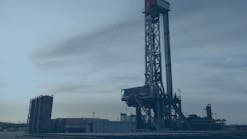ACCORDING TO MIKE CRAIG, Unocal Oil & Gas Operation's civil engineering and construction coordinator in Lafayette, La., the company's perspective on abandonment, or "decommissioning," includes the following three points:
1. Effects of potential abandonment liability cost estimating on company financials2. Efficient execution of abandonment projects
3. Suggestions for industry and regulatory improvements relating to abandonment.
Liability estimating
The costs to abandon each asset, such as well, platform, plant, or pipeline, owned or shared by an operator must be estimated for portfolio management and accounting purposes. For larger operators with potential abandonment liability costs in the billions, this is a massive and complex task, especially when the costs are generated by diverse groups within the company.
To improve this work, Unocal has developed a process to systematically consolidate, develop, and check abandonment cost estimates for all its upstream oil and gas facilities. To account for uncertainties in regulatory requirements, market conditions, and other factors, cost estimates are described in a probabilistic format with a range of values.
For example, a deepwater Gulf of Mexico fixed structure could cost from $4 million to $45 million to abandon, depending on the regulatory requirements in place at the time. A probabilistic distribution of 50% (P50) "best guess" values are used in Unocal's depletion plans. They reflect current market rates and projected regulatory requirements. This process also aids in long-term planning of abandonment projects.
Project execution
Unocal's Gulf of Mexico operations are presently spread across 15 asset teams, 11 offshore and 4 onshore. Each team is responsible for the economic and safety performance of the assets within its respective geographic boundaries.
When production from these assets becomes uneconomic, their abandonment must be executed with maximum efficiency and safety because money and time spent on abandonment subtract from the bottom line. In other words, the work is not revenue generating.
To better enable asset team personnel to focus on adding reserves and enhancing production, Unocal recently established a standing Gulf of Mexico plug and abandonment (P&A) support team to implement this work on behalf of the asset teams. This P&A team basically comprises a drilling person and a construction person, each with primary responsibilities outside P&A work.
In 1995, the initial P&A team abandoned 27 wells, 21 structures, and 22 pipelines for a cost of $7 million net with no lost time accidents. For the work, it issued 194 bids and requested 93 permits. Most of this work was in old, shallow-water fields.
Two jackets were reefed (toppled in place), and two decks were sold. Structures removed exceeded the number of new structures installed by a factor of two.
To do this work, the P&A team outsourced to consulting companies highly experienced in abandonment work, and emphasized the use of basic project management principles such as:
- Thorough planning such as early permitting, efficient work packaging, scheduling for good weather, and maximizing the use of reefing, reuse, and explosives.
- Appropriate contracting such as basically lump sum contracting for less complex work, and T&M (time and material) contracting of risky work under close field supervision.
- "Right" outsourcing and full delegation to reputable contractors, especially in well P&A, not just to the lowest bidder.
- Clear communications with the asset team clients such as early identification of critical path hurdles and weekly progress reports with timeline and cost updates.
This work focus allowed more productive time for asset teams, a focus of drilling and construction expertise, cost effective grouping of abandonment work packages, focused resale and reuse opportunities, and the integration of abandonment work into new construction projects at less cost.
Suggested improvements
A list of improvements that the industry could make to save money are:
- Establish a third-party, centralized clearing house for used Gulf of Mexico structures and facilities, to be made available for sale and reuse.
- Proactively support further development of severing techniques, including smaller explosive charges, and especially improved nonexplosive severing options.
- Help itself by planning and packaging its abandonment work as far ahead as practical.
- Support efforts to better quantify fish kills during platform abandonment, especially in relation to unwanted catch (bycatch) by the fishing industry.
- Support recommendations, some of the caveats, made by the National Research Council's Marine Board committee such as structure and well removals to 3 ft below mudline instead of 15 ft, no limit to the number of consecutive charges, and partial removal of structures in more than 300 ft of water to a depth of 85 ft below the water line.

